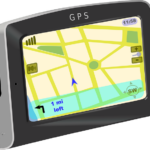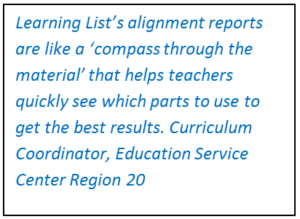Learning List’s alignment reports help teachers select materials that are aligned to the standards they need to teach. Then, like a GPS through the product, our alignment reports show teachers specific citations in the material that they can use to address each standard fully.
Learning List’s Alignment Reports
Our alignment reports show (a) the percentage of standards to which the material is aligned, (b) the standards to which the material is aligned and is not aligned, and (c) specific citations (e.g., pages, lessons videos) that have been independently verified to be aligned to each standard.[1] [Read More …]
When reviewing the alignment of a material, our subject matter experts review multiple citations (e.g., pages, lessons, videos) listed in the publisher’s correlation for alignment to each standard.[2] For some products, this means that Learning List will have reviewed all of the citations listed in the publisher’s correlation; for others, it means that Learning List has reviewed several but not all of the publisher’s citations. I was recently asked: “How are your alignment reports useful if you do not review all of the citations in the publisher’s correlation?”
We constructed our review methodology to balance subscribers’ need for a thorough review against their need for a timely review. Some publishers list more than 20 citations as aligned to each standard. If we were to review all of the listed citations, it would take months instead of weeks to complete a review, and educators told us that the resulting alignment reports would be too cumbersome to use.
How You Can Use Our Alignment Reports to Get the Most Value from Your Materials
Even if we have not reviewed every citation listed in the publisher’s correlation, our alignment reports can help educators get the most instructional value from their materials in the following ways:
- To Identify Resources Aligned to Certain Standards: Our alignment reports help educators quickly identify which materials are aligned to the standards they intend to teach.
An instructional coach called our office one day in a state of euphoria. She explained that her district has a room filled with boxes of materials, most unopened, that she was told to use for small group instruction. She had no idea whi ch box to open, never mind which pages to assign in each material. She learned that her district subscribed to Learning List and had just logged into our site for the first time. She told us that our alignment comparison tool and detailed alignment reports provided exactly the information she needed to design targeted instruction for each group of students. She said we’d saved her months of work and had given her confidence that she’d never felt in her job, as she knew she would now be providing the right resources to support her students.
ch box to open, never mind which pages to assign in each material. She learned that her district subscribed to Learning List and had just logged into our site for the first time. She told us that our alignment comparison tool and detailed alignment reports provided exactly the information she needed to design targeted instruction for each group of students. She said we’d saved her months of work and had given her confidence that she’d never felt in her job, as she knew she would now be providing the right resources to support her students.
- To Reteach Standards: Teachers who want to use their core material “cover to cover” can use the “aligned citations” in our alignment reports to strategically reteach standards students are struggling with.
- To Identify Multiple Resources to Use In Lessons/To Use Multiple Resources for Differentiation: Teachers who want to incorporate multiple resources in a lesson can use our alignment reports to identify an “aligned citation” from each resource to teach the standard(s) the lesson covers.
- As a Predictor of Alignment: If a teacher wants to use a citation from the publisher’s correlation that we have not reviewed, our alignment report can serve as a guide to/predictor of the probability that the additional citation is aligned to that standard. For example:
- If our alignment report shows that only two of the five citations we reviewed were aligned to the standard, then there is a strong possibility that the additional citation may not be aligned to that standard. Thus, the teacher would probably want to review the alignment of that citation carefully before using it.

- If, on the other hand, our alignment report shows that all of the citations we reviewed were aligned to that standard, the teacher can be more confident that the additional citation he/she wants to use will be aligned to that standard.
- As a Self-Check on the Teacher’s Own Alignment Decisions: Teachers who want to review the alignment of their materials themselves can use our alignment reports as an independent self-check, since alignment determinations often are not black-and-white.
Furthermore, teachers generally have time to review only one or two citations for alignment to each standard. They may lose faith in the material if neither citation is aligned. We review multiple citations for alignment to each standard. While we review each citation’s alignment individually, we sometimes find that although a single citation is not completely aligned, if several of the reviewed citations are used together, the material is fully aligned to the standard. Our alignment reports explain when and which citations must be “bundled” in order to address the entire standard.
Finally, our alignment reports are often more detailed than the publisher’s correlation sold with the material. For example, College Board requires publishers to submit Advanced Placement (AP®) materials (for several courses) to us for review in order to for the materials to be eligible to be selected for an AP Example Textbook List. Often, the correlation AP publishers develop for our review is significantly more specific than the correlation that accompanies their material. The same is true when publishers submit adaptive materials for our review. Thus, our alignment reports often provide teachers with more textual evidence of the alignment of a material than the publisher’s correlation provides.
Learning List’s alignment reports help teachers identify specific materials and specific citations within those materials that are aligned to the standards they need to teach. In addition to facilitating a selection process and giving educators peace of mind that they are selecting the best materials for their students, our alignment reports help educators use their materials most effectively for instruction in the five different ways explained above.
[1] Our alignment reports list each reviewed citation as either an “aligned citation” or a “non-aligned citation.” A citation is listed as “aligned” only if it addresses the content, context and the cognitive demand required by the standard. In other words, citations listed as “aligned citations” have been verified to teach all of the content knowledge and skills the standard requires students to learn in the appropriate context. Each non-aligned citation is accompanied by a Reviewer’s Comment explaining precisely which part of the standard the citation failed to address.
[2] For materials aligned to the Texas Essential Knowledge and Skills (TEKS), “Standard” refers to each Breakout of each Student Expectation. For materials aligned to the Advanced Placement (AP) course frameworks, “Standard” refers to Learning Objectives (LOs), Essential Knowledge Statements (EKs), Historical Thinking Skills or Mathematical Practices, as dictated by the course framework. For Next Generation Science Standards, “Standard” refers to Evidence Statements, Evidence Statement Components, or Evidence Statement Elements.
9 thoughts on “5 Ways Learning List’s Alignment Reports Help You Get the Biggest “Bang for Your Buck” from Your Materials”
Comments are closed.